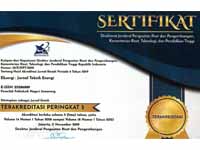EVALUASI KINERJA AIR-COOLED WATER CHILLER DENGAN KAPASITAS 594 kW
DOI:
https://doi.org/10.32497/eksergi.v17i3.2982Keywords:
COP, air-cooled chiller, sistem refrigerasiAbstract
Kinerja mesin Air-Cooled Water Chiller (ACWC) harus memenuhi standar SNI 03-6390-2020, yaitu minimal COP 3 dan konsumsi energy minimal 1,172 kW/TR. Untuk pemenuhan standar tersebut, dilakukan evaluasi kinerja terhadap ACWC kapasitas 594 kW. Tahap awal evaluasi adalah pengukuran temperatur (input dan output) air di evaporator dan daya listrik pada kompresor pada mesin chiller. Pengambilan data dilakukan untuk sekali siklus dan temperatur output air antara 11oC -15oC. Dengan perhitungan diperoleh beban pendinginan (Net Refrigeration Capacity) sebesar 97,003 TRatau 341,158 kW, daya kompresor sebesr 212,483 kW, konsumsi energi 2,203 (kW/TR) dan COP sebesar 1,605. Tahapan selanjutnya adalah membandingkan COP aktual dan konsumsi energi sesuai standar. Hasil analisis menunjukan bahwa rata-rata COP dari 7 siklus sebesar 2,203, sedangkan konsumsi energi adalah 2,203 kW/TR. Nilai COP tidak memenuhi standar diakibatkan mesin chiller bekerja dengan beban 57,43% dari kapasitas pabrikan.
References
Gupta, O. P. (2018). Energy Technology. New Delhi: Khanna Book Publishing.
Alshakhshir, F. S., & Howell, M. T. (2021). Data Driven Energy Centered
Maintenance. Gistrup: CRC Press.
Capehart, B. L., Kennedy, W. J., & Turner, W. C. (2020). Guide to Energy Management,
Eight Edition - International Version. United State: River Publisher.
Desai, S. (2015). Energy Audit. New Delhi: McGraw-Hil Education (India) Private
Limited.
Knight, J., & Jones, P. (2011). Building Service. New York: Spon Press.
BPPT, T. (2015). PROSEDUR STANDAR DAN TEKNIK AUDIT DI INDUSTRI.
Tangerang Selatan: Badan Pengkajian dan Penerapan Teknologi.
Published
Issue
Section
License
Authors who publish with this journal agree to the following terms:Authors retain copyright and grant the journal right of first publication with the work simultaneously licensed under a Creative Commons Attribution License that allows others to share the work with an acknowledgement of the work's authorship and initial publication in this journal.
Authors are able to enter into separate, additional contractual arrangements for the non-exclusive distribution of the journal's published version of the work (e.g., post it to an institutional repository or publish it in a book), with an acknowledgement of its initial publication in this journal.
Authors are permitted and encouraged to post their work online (e.g., in institutional repositories or on their website) prior to and during the submission process, as it can lead to productive exchanges, as well as earlier and greater citation of published work (See The Effect of Open Access).






